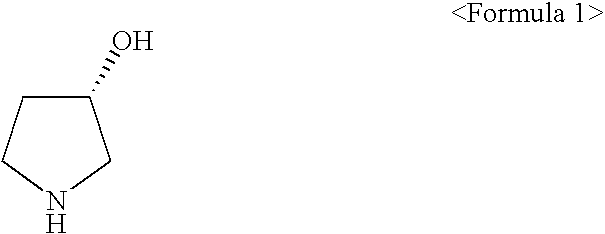Synthetic method of optically pure (S)-3-hydroxypyrrolidine
a technology of s-hydroxypyrrolidine and s-hydroxypyrrolidine, which is applied in the direction of bulk chemical production, organic chemistry, etc., can solve the problems of difficult industrial handling, difficult to apply to mass production, and high cost of starting material (r)-3-hydroxy-l-proline,
- Summary
- Abstract
- Description
- Claims
- Application Information
AI Technical Summary
Benefits of technology
Problems solved by technology
Method used
Image
Examples
example 1
Preparation of 4-ethoxycarbonylamino-(S)-2-hydroxybutylic acid 3
[0070]Distilled water (150□) and 4-amino-(S)-2-hydroxybutylic acid 2 (0.84 mol, 100 g), and sodium hydroxide (1.68 mol, 67 g) were added to a 1000□ round-bottom flask and completely dissolved. The mixture was cooled down below 5° C. After a solution prepared by dissolving ethyl chloroformate (1.00 mol, 109 g) in 1,4-dioxane (100□) was gently dropped to the cooled mixture, the resulting mixture was agitated for 2 hours while maintaining reaction temperature at room temperature. The completion of the reaction was confirmed by TLC. The reaction mixture was concentrated under reduced pressure and cooled down to 10° C., and then, its pH was lowered to 1.2 or less by adding concentrated hydrochloric acid. The resulting mixture was extracted with ethyl acetate (450□), and the extract thus obtained was dried with anhydrous magnesium sulfate and then filtered and concentrated to obtain 153 g of 4-ethoxycarbonylamino-(S)-2-hydrox...
example 2
Preparation of 4-ethoxycarbonylamino-(S)-2-hydroxybutylic acid ethylester 4
[0072]After 4-ethoxycarbonylamino-(S)-2-hydroxybutylic acid 3 (0.523 mol, 100 g) and 240□ of anhydrous alcohol were added to a 500□ round-bottom flask and completely dissolved, 5 g of concentrated sulfuric acid was gradually dropped thereto. The mixture was reacted under reflux for 10 hours. After the reaction was completed, the reaction mixture was cooled down to room temperature, neutralized with sodium bicarbonate, and then concentrated under reduced pressure to obtain 110 g of crude 4-ethoxycarbonylamino-(S)-2-hydroxybutylic acid ethylester 4.
[0073]1H-NMR (DMSO-d6): δ 4.03-4.2 (m, 3H), 3.9-4.0 (m, 2H), 3.03 (m, 2H), 1.2-2.0 (m, 2H), 1.0-1.2 (m, 6H).
example 3
Preparation of 4-ethoxycarbonylamino-(S)-1,2-butandiol 5
[0074]Sodium borohydride (1.00 mol, 37.8 g) and 200□ of anhydrous ethanol were added to a 1000□ round-bottom flask, and reaction temperature was lowered to 5° C. While carefully maintaining the reaction temperature below 15° C., a solution prepared by dissolving 4-ethoxycarbonylamino-(S)-2-hydroxybutylic acid ethylester 4 (0.502 mol, 110 g) in 240□ of anhydrous ethanol was gradually added to the mixture. The reaction mixture was agitated for 6 hours while maintaining the reaction temperature at 20° C. After the completion of the reaction was confirmed, the reaction mixture was cooled down and kept below 5° C. The reaction mixture was added with 100□ of methanol and agitated for 1 hour to inactivate sodium borohydride. Then, pH of the reaction mixture was adjusted to 1.2 or less by adding concentrated hydrochloric acid, and agitated at 5° C. for 1 hour. The final reaction mixture was filtered under reduced pressure to remove cry...
PUM
| Property | Measurement | Unit |
|---|---|---|
| temperature | aaaaa | aaaaa |
| temperature | aaaaa | aaaaa |
| temperature | aaaaa | aaaaa |
Abstract
Description
Claims
Application Information
 Login to View More
Login to View More - R&D
- Intellectual Property
- Life Sciences
- Materials
- Tech Scout
- Unparalleled Data Quality
- Higher Quality Content
- 60% Fewer Hallucinations
Browse by: Latest US Patents, China's latest patents, Technical Efficacy Thesaurus, Application Domain, Technology Topic, Popular Technical Reports.
© 2025 PatSnap. All rights reserved.Legal|Privacy policy|Modern Slavery Act Transparency Statement|Sitemap|About US| Contact US: help@patsnap.com



